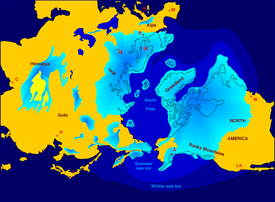Variations in the Sun's energy output
There are at least two types of variation in the Sun's energy output
- In the very long term, astrophysicists believe that the Sun's output increases by about 7% every one billion (109) years.
- Shorter-term variations such as sunspot cycles, and longer episodes such as the Maunder minimum, which occurred during the coldest part of the Little Ice Age.
The long-term increase in the Sun's output cannot be a cause of ice ages.
Volcanism
Volcanic eruptions may have contributed to the inception and/or the end of ice age periods. At times during the paleoclimate, carbon dioxide levels were two or three times greater than today. Volcanoes and movements in continental plates contributed to high amounts of CO2 in the atmosphere. Carbon dioxide from volcanoes probably contributed to periods with highest overall temperatures.[60] One suggested explanation of the Paleocene-Eocene Thermal Maximum is that undersea volcanoes released methane fromclathrates and thus caused a large and rapid increase in the greenhouse effect.[citation needed] There appears to be no geological evidence for such eruptions at the right time, but this does not prove they did not happen.

No comments:
Post a Comment